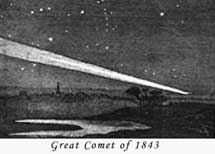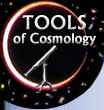|

|
Alvan
Clark was born
in Massachusetts and, after working briefly for a wagon maker, spent several
years engraving the cylinders used to print patterns on cloth. In 1844,
his oldest son, George Bassett, tried to make a small telescope. This
encouraged Alvan to try his hand at telescopes. His interest was no doubt
fostered by the growing American market for telescopes. The Americans
had taken a great interest in astronomy, spurred by the appearance of
a spectacular comet in 1843.
 |
The
Great Comet of 1843
as seen from Kent, England.
|
Alvan
Clark taught himself
how to grind lenses, and was soon joined by his two sons in making telescopes
of modest size. By 1855, Alvan Clark & Sons, George and Alvan Graham,
had made over a dozen lenses ranging in size from four to seven inches.
They used their instruments to discover several new double stars. In 1860,
officials from the University of Mississippi asked the Clarks to make
a refractor with an aperture of 19.2 inches. That would make it the world's
largest, gathering 50 percent more light than Harvard's 15-inch. After
some hesitation, Clark and his sons took on the task. They had the telescope
ready for delivery in 1862, but could not collect their fee. For the Civil
War was at its height, and the University of Mississippi could not take
delivery. Finally, in 1866, the instrument went to the University of Chicago's
Dearborn Observatory. Later, in 1889, it was moved to Northwestern University.
Alvan
Clark & Sons surpassed this achievement in 1873, when they made the lens
and mounting for a 26-inch telescope for the United States Naval Observatory
at a cost of $50,000). A decade later they created a 30-inch lens for
Russia's Pulkovo Observatory. This work culminated in the great 36-inch
Lick and 40-inch Yerke refractors.
|


